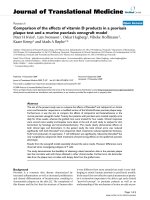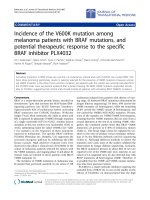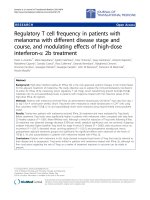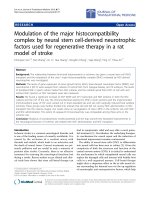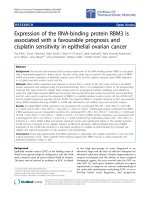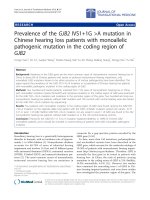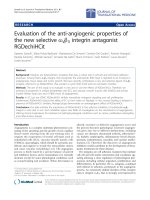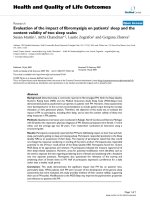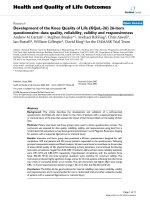báo cáo hóa học:"Assessment of self-injection experience in patients with rheumatoid arthritis: psychometric validation of the Self-Injection Assessment Questionnaire (SIAQ)" ppt
Bạn đang xem bản rút gọn của tài liệu. Xem và tải ngay bản đầy đủ của tài liệu tại đây (567.86 KB, 11 trang )
RESEARCH Open Access
Assessment of self-injection experience in
patients with rheumatoid arthritis: psychometric
validation of the Self-Injection Assessment
Questionnaire (SIAQ)
Dorothy Keininger, Geoffroy Coteur
*
Abstract
Background: Subcutaneous self-injection of medication has benefits for the patient and healthcare system, but
there are barriers such as dexterity problems and injection anxiety that can prevent self-injection being used
effectively. An accurate method of evaluating patients’ experiences with self-injection would enable assessment of
their success in giving self-injections and the likelihood of them adhering to a self-injection regimen. The aim of
this study was to develop a questionnaire to measure overall patient experience with subcutaneous self-injection
(the Self-Injection Assessment Questionnaire [SIAQ]), and to investigate its psychometric properties.
Methods: The construct validity and reliability of the SIAQ were tested in patients with rheumatoid arthritis who
volunteered to inject certolizumab pegol using a standard syringe during an open-label multinational extension
trial of the long-term safety and efficacy of this drug. The SIAQ PRE module was self-completed before the first
self-injection, and the POST module was self-completed following each of three fortnightly self-injections.
Results: Ninety-seven patients completed the SIAQ. All items correlated well with their respective domains in
confirmatory factor analysis. As predicted, compared with other participants, patients with very low scores (less
than 3 out of 10) in PRE causal domains (Feelings about injections and Self-confidence) were significantly less
satisfied with their first self-injection, as were patients with a very low score in any POST causal domain (Self-
confidence, Feelings about injections, Injection-site reactions and Ease of use), demonstrating known-groups
validity. Causal domain scores generally correlated most strongly with the Satisfaction with self-injection domain,
supporting convergent validity. The SIAQ demonstrated internal consistency and reproducibility; Cronbach’s a and
the test-retest coefficient were > 0.70 for all domains. Sensitivity and responsiveness were also shown, where
measurable. Each language version showed structural validity.
Conclusion: The SIAQ was demonstrated to be a valid, reliable tool in patients with rheumatoid arthritis.
Background
Rheumatoid arthritis (RA) is a chronic autoimmune dis-
ease that is associated with increased morbidity and
mortality, and requires long-term treatment [1,2]. The
disease leads to pain, fatigue and impairment in physical
function, which limit activities and result in a significant
decline in health-related quality of life (HRQoL) [3].
Disease-modifying anti-rheumatic drugs (DMARDs)
have been demonstrated to improve physical function
and HRQoL [4] . Anti-tumour necrosis factor drugs
(anti-TNFs) are biologic DMARDs that are effective in
inhibiting disease progression [5,6].
Anti-TNFs can be administered by intravenous infu-
sion or by subcutaneous injection. While intravenous
infusion requires commitment to regular clinic visits,
subcutaneous injection offers the option of self-adminis-
tration and is likely to provide a better treatment experi-
ence for patients. Patients with chronic diseases who are
able to self-inject their medication gain control of their
treatment schedule (within the limits imposed by the
* Correspondence:
UCB Pharma SA, Brussels, Belgium
Keininger and Coteur Health and Quality of Life Outcomes 2011, 9:2
/>© 2011 Keininger and Coteur; licensee BioMed Central Ltd. This is an Open Access article distributed under the terms of the Creative
Commons Attribution License (http://cr eativecommons.org/lice nses/by/2.0), which permits unrestricte d use, distribution, and
reproduction in any medium, provided the original work is properly cited.
product label) and their treatment setting, thus allowing
greater independence and freedom in their social,
domestic and professional lives [7,8]. Self-injection may
also offer psychological benefits over administration by
healthcare professionals, including improved self-esteem
[9,10]. This improved treatment experience may lead to
better adherence, improved therapeutic outcomes and
improved HRQoL. Removing the need to attend a clinic
or hospital for regular injections also brings economic
benefits to both the patient and the healthcare system.
There are, however, several potential barriers to self-
injection [7,8]. Dexterity problems, commonly found in
patients with RA, are potential physical barriers to self-
injection. Among patient groups that self-inject, psycho-
logical and social barriers, such as injection anxiety, lack
of confidence in giving a self-injection, and potential
embarrassment associated with s elf-injecting in public,
can also be problematic. One in five people are esti-
mated to experience injection anxiety [11], but this pre-
valence may be substantially greater in some patient
groups such as younger patients and those with a his-
tory of fainting following injection [11,12].
There is a need to as sess the patient s’ experience with
self-injection, and to gauge their success in giving self-
injections and the likelihood of them adhering to a self-
injection regim en. The Self- Injection Assessment Ques-
tionnaire (SIAQ) (
©
UCB, Braine L’ All eud, Belgium
2006) was developed to assess overall patient experience
with subcutaneous self-injection. It assesses the per-
ceived advantages of self-injection and the potential bar-
riers to self-injection, including psychological barriers,
social barriers and physical barriers, as well as satisfac-
tion with self-injection and willingness to c ontinue the
treatment by self-injection. The SIAQ was developed
using a four-step process involving patients with either
RA or Crohn’s disease (CD). It was designed to evaluate
the patient’s perceptions before and after they self-inject,
and to be suitable for use in clinical studies. The SIAQ
can also be used to guide decisions regarding mode of
administration when prescribing an anti-TNF.
The aim of this study was to assess the psychometric
properties of the SIAQ and to refine it, if necessary.
Data for this evaluation were obtained from patients
with active RA who were able, in the opinion of their
physicians, to self-inject certolizumab pegol, the only
PEGylated anti-TNF treatment, as part of a long-term
extension of the Rheumatoid Arthritis PreventIon of
structural Damage 2 (RAPID 2) study [13].
Methods
Questionnaire development
The initial version of the SIAQ (SIAQ
v1.0
)wasdevel-
oped in accordance with a rigorous process based on
the draft Food and Drug Administration (FDA) Gui-
dance on Patient Reported Outcomes [14,15].
In-depth structured focus groups and indiv idual inter-
views were carried out with 12 patients with RA or CD in
the USA to understand their perceptions of self-injection
(Figure 1). Patients’ verbatim comments were also col-
lected to help develop the questionnaire. Six of the
patients involved in this stage had RA and six had C D.
Ten patients were female, and the mean age was 53 years
(range: 24-67 years). The majority of the patients were of
North American/European/Caucasian origin (n = 8). Six
patients had a college or university degree, seven were in
full- or part-time work and six were married.
A qualitative analysis of the in-depth discussions was
performed to develop a conceptual model that grouped
the concepts that were relevant to the patients. This
model was used to construct the questionnaire, with
each ‘concept’ subsequently represented by a hypothet i-
cal domain. Items were generated in US English using
patients’ verbat im comments and grouped within the
relevant domains. The SIAQ
v1.0
wasdesignedastwo
Figure 1 Study design.
Keininger and Coteur Health and Quality of Life Outcomes 2011, 9:2
/>Page 2 of 11
modules: one that was designed to be completed by
patients before their first self-injection (PRE module);
and one that was designed to be completed by patients
after self-injection (POST module). All items in the PRE
module were repeated in the POST module, allowing
comparison of patients’ feelings about injections before
and after self-injection.
Eight items were generated for the PRE module,
which were grouped into three hypothetical domains
(General feelings about injections, Feelings about giving
self-injections, and Satisfaction with self-injection)
(Table 1). Twenty-three items were generated for the
POST module, with two of these being divided into
eight sub-items (Table 2). The items were grouped into
six hypothetical domains (General feelings about injec-
tions, Feelings about giving self-injections, Injection-
site reaction burden, Device features, Satisfaction with
self-injection, and Willingness to continue to self-
inject). The first four domains of the POST module
were hypothesized to be causal concepts according to
the conceptual model, because they were considered
determining factors of satisfaction with self-injection
and willingness to continue (Figure 2a).
Content validity and acceptability of the items were
evaluated through cognitive debriefing interviews that
were conducted with a new group of patients. Five
patients with CD and five patients with RA took part in
these cognitive debriefing interviews. Six of these parti-
cipants were female, and the mean age was 43 years
(range: 20-63 years).
The o riginal US English language version of the
SIAQ
v1.0
was translated into Czech and Polish. Lingu istic
adaptation was undertaken by translation professionals
using a validated procedure that involved five steps [16].
These were: forward translation by two independent
translators; reconciliation of the two translations; back-
ward translation b y an independent translator; compari-
son of the source questionnaire with the backward
translation by a local consultant and the translation pro-
fessionals; and cognitive debriefing with five patients with
either CD or RA. Minor modifications were made follow-
ing this validati on procedure to improv e the translatabil-
ity of the questionnaire.
Psychometric validation
Study design
The psychometric properties of the SIAQ were investi-
gated in a dult patients in the USA, Poland and the
Czech Republic who were enrolled in a multicentre,
open-label, single-arm extension of the RAPID 2 trial
assessing the long-term safety and efficacy of certolizu-
mab pegol in addition to methotrexate in the treatment
of active RA [13]. All participating patients provided
written informed consent. Patients were not given any
incentives to complete the study.
Participants were invited to self-inject 400 mg certoli-
zumab pegol as two 1-mL injections at separate injec-
tion sites (lateral abdominal wall and upper outer t high
were suitable sites) using a pre-filled standard syringe.
Patients who agreed to participate and who were judged
by the investigators to be capable of safely and effec-
tively administering the treatment were included
in the self-injection study. Patient capability was not
pre-defined and was left to the treating physician’sdis-
cretion. The self-injections were carried out at th ree
consecutive visits planned every 2 weeks. Training was
provided at each visit, along with written instructions on
the recommended subcutaneous injection technique.
Patients self-injected under supervision of the site staff
to ensure that the study medication was properly and
safely injected. Patients rated their perceptions about
self-injections using the SIAQ
v1.0
before the first self-
injection and at each self-injection visit (SIV). All
patients who completed at least one of the three SIVs
and one POST module assessment were included in the
analysis.
Table 1 The structure of the PRE module of the Self-Injection Assessment Questionnaire
©
(SIAQ)
v1.0
and the SIAQv1.1
Items Hypothetical domains (v1.0) Refined domains (v1.1)
1. In general, how afraid are you of needles? General feelings about injections Feelings about injections
2. In general, how afraid are you of having an injection?
3. How anxious do you feel about giving yourself an injection? Feelings about giving self-injections
4. How confident are you about giving yourself an injection in the
right way?
Self-confidence
5. How confident are you about giving yourself an injection in a clean
and sterile way?
6. How confident are you about giving yourself an injection safely?
7. Does your current way of taking your medication make you feel in
control of your disease?
DELETED
8. Overall, how satisfied are you with your current way of taking your
medication?
Satisfaction with self-injection Satisfaction with self-injection
Keininger and Coteur Health and Quality of Life Outcomes 2011, 9:2
/>Page 3 of 11
Participation was voluntary and patients could with-
draw fro m the self-injection study at any time and con-
tinue with the original study. The study protocol was
approved by the appropriate Ethics Committees and
Institutional Review Boards.
Questionnaire administration and scoring
The two modules of the SIAQ
v1.0
were completed by
patients while alone in a quiet environment. The PRE
module was completed imme diately before the first
self-injection and the POST module was completed
Table 2 The structure of the POST module of the Self-Injection Assessment Questionnaire
©
(SIAQ)
v1.0
and the SIAQv1.1
Items and sub-items Hypothetical domains (v1.0) Refined domains
(v1.1)
1. In general, how afraid are you of needles? General feelings about injections Feelings about
injections
2. In general, how afraid are you of having an injection?
3. How anxious do you feel about giving yourself an injection? Feelings about giving
self-injections
4. How embarrassed would you feel if someone saw you with the self-injection device? Self-image
5. How confident are you about giving yourself an injection in the right way? Self-confidence
6. How confident are you about giving yourself an injection in a clean and sterile way?
7. How confident are you about giving yourself an injection safely?
8. Does your current way of taking your medication (self-injection) make you feel in
control of your disease?
DELETED
9a. During and/or after the injection, how bothered were you by pain? Injection-site reaction burden Injection-site reactions
9b. During and/or after the injection, how bothered were you by burning sensation?
9c. During and/or after the injection, how bothered were you by cold sensation?
10a. During and/or after the injection, how bothered were you by itching at the
injection site?
10b. During and/or after the injection, how bothered were you by redness at the
injection site?
10c. During and/or after the injection, how bothered were you by swelling at the
injection site?
10d. During and/or after the injection, how bothered were you by bruising at the
injection site?
10e. During and/or after the injection, how bothered were you by hardening at the
injection site?
11. How much do you agree or disagree with the following: the cap is easy to remove. Device features Ease of use
12. How much do you agree or disagree with the following: the device fits comfortably
in my hand.
13. How much do you agree or disagree with the following: I can easily depress the
plunger or button on the device.
14. How much do you agree or disagree with the following: I can administer the
injection without any help.
15. How much do you agree or disagree with the following: the self-injection device is
easy to use.
16. How easy was it to give yourself an injection? Satisfaction with self-injection Satisfaction with
self-injection
17. How satisfied are you with how often you give yourself an injection?
18. How satisfied are you with the time it takes to inject the medication?
19. Overall, how satisfied are you with your current way of taking your medication
(self-injection)?
20. Overall, how convenient is the self-injection device?
21. Overall, how comfortable is the injection? DELETED
22. After this study, would you choose to continue self-injecting your medication? Willingness to continue to
self-inject
Satisfaction with
self-injection
23. After this study, how confident would you be to give yourself injections at home?
Keininger and Coteur Health and Quality of Life Outcomes 2011, 9:2
/>Page 4 of 11
20-40 minutes after dosing at each SIV, based on the
combined experience of the two i njections at that visit.
There is no stipulated recall period for the SIAQ,
because the recall period varies from one domain to
another. For example, items from the Injection-site reac-
tion burden domain refer to the patient’sexperience
during or after the injection, whereas items from the
General feelings about injections domain refer to general
attitudes.
Patients rated each item of the SIAQ on a 5-point
semantic Likert-type scale, where a score of 1 corre-
sponded to the patient’s worst experience and a score of
5 corresponded to the patient’s best experience. Item
scores were transformed to obtain a score ranging from
0 (worst experience) to 10 (best experience) for each
item.Thedomainscorewasthemeanoftheitem
score s included in the d omain. Domain scores were cal-
culated only if at least half of the domain items were
completed.
Initial evaluation and refinement of the SIAQ
v1.0
Patient data obtained with the POST module at the first
SIV (SIV-1) were used for an ex ploratory factor analysis
to evaluate the hypothetical structure of the SIAQ
v1.0
.
Appropriate modific ations to the SIAQ structure and
conceptual model were subsequently made to produce
the SIAQ version 1.1 (SIAQ
v1.1
). The varimax method
of factor rotati on was used and factors with an eigenva-
lue > 1 were retained. The psychometric properties of
the SIAQ
v1.1
(construct validity and reliability [17]) were
invest igated using data obtained from the relevant items
of the SIAQ
v1.0
, b ut applied to the new conceptual
model and questionnaire structure.
Construct validity of the SIAQ
v1.1
To assess the extent to which the questionnaire mea-
sured the intended concepts, the construct validity of
the refined questionnaire (SIAQ
v1.1
) was examined using
confirmatory factor analysis, goodness-of-fit indices,
known-groups validity and convergent validity.
Two confirmatory f actor analyses were performed to
evaluate the construct validity of both the PRE a nd the
POST SIAQ
v1.1
modules, using item scores from the
PRE module and from SIV-3, respectively. Items that
correlated with their respective domain with a coeffi-
cient of ≥ 0.5 were considered to have g ood construct
validity [18].
The goodness-of-fit of the data to the new structure
was assessed using four fit indices: the Bentler’ scom-
parative fit index (CFI), which ranges from 0 to 1, with
higher values indicating better fit and where 0.90 is con-
sidered an adequate fit [19]; the normed fit index (NFI)
where a value of 0.90-0.95 is acceptable and a value of >
0.95 is good [19];
the root mean square error of approximation
(RMSEA), where a value of < 0.05 indicates a good fit,
0.05-0.1 a reasonable fit and > 0.1 a poor fit [20]; and
the root mean square residual (RMR), where a value of <
0.05 indicates a good fit [21].
Known-groups validity is demonstrated when an
instrument is sensitive enough to discriminate between
groups of individuals known to be different according to
the variables being measured [22]. From the refined
conceptual model (Figure 2b), it was hypothesized that
patients with greater fear or anxiety before the first self-
injection (PRE Feelings about injections domain scores ≤
2), lower self-confidence before the first self-injection
(PRE Self-confidence domain scores ≤ 2) or a worse
Figure 2 The hypothetical (a) and refined (b) conceptual
models of the Self-Injection Assessment Questionnaire
©
version 1.0 (SIAQ
v1.0
). Causal concepts are indicated in light grey
boxes.
Keininger and Coteur Health and Quality of Life Outcomes 2011, 9:2
/>Page 5 of 11
experience in any of the causal domains after the first
self-injection (POST SIV-1 domain scores ≤ 2) would
have a lower level of satisfaction with their first self-injec-
tion than patients with higher domain scores (> 2). Stu-
dent t-tests for independent samples were performed
to assess potential differences in Satisfaction with self-
injection scores at SIV-1.
Convergent validity i s demonstrated when two or
more measures that are theoretically related are actually
observed to be related [22]. Convergent validity was
investigated, using data from SIV-1, by evaluating
whether causal domains (Feelings about injections, Self-
confidence, Injection-site reactions, Ease of use, and
Self-image)weremorestronglycorrelatedwiththe
Satisfaction with self-injection domain than with each
other, as hypothesi zed by the refined concept ual model.
The correlation betwee n the Satisfaction with self-injec-
tion domain score and the combined mean of all causal
domains was also evaluated, and was expected to be
high (> 0.5).
Reliability of the SIAQ
v1.1
Reliability was assessed to ascertain the extent to which
the questionnaire yielded the same score when expected.
This reliabi lity assessment comprised measurement pre-
cision (floor and ceiling effects, and internal consis-
tency), reproducibility (test-retest reliability), sensitivity
(between-groups discrimination), and responsiveness
(within-groups discrimination). The presence of floor
(an excess of minimum scores) and ceiling (an excess of
maximum scores) effects wereexaminedbycalculating
the distribution of domain scores at SIV-1. Floor or ceil-
ing effects indicate that a domain might have poo r sen-
sitivity or responsiveness, as further deterioration or
improvement will not be measurable in patients with
low or high scores, respectively [23].
Internal consistency was evaluated using Cronbach’s a
coefficient [24] to determine the extent to which item
scores correlated with dimension scores before and after
the first self-injection. An a coefficient above 0.70 sug-
gests good internal consistency and reliability [25].
Test-retest reliability is a measure of the stability of
the instrument under different conditions with the same
rater. The intraclass correlation coefficient (ICC) was
used to measure the strength of agreement between
domain scores as assessed at SIV-2 and SIV-3. Overall
perceptions about self-injections were expected to
change earlier in the study and be maintained later in
the study, so the SIV-2 and SIV-3 were expected to
remain fairly stable. A test-retest coefficient above 0.70
was considered acceptable [26].
The sensitivity of an instrument is its abi lity to detect
differences between patients or groups of patients. The
single-arm design of the study limited the assessment of
sensitivity, which could be tested only for the Satisfaction
with self-injectio n domain, as per t he known-groups
construct validity analysis (see above).
Responsiveness relates to the ability of an instrument
to detect changes when a patient improves or deterio-
rates [22]. To test res ponsiveness, the two domain scores
tha t were expected to improve ( Feeli ngs about injections
and Self-confidence) were compared using t-tests for
paired samples before the first self-injection and after
SIV-3. The effect size was also calculated to assess the
magnitude of these expected improvements [27].
Language and country effects
SIAQ
v1.1
domain scores were compared among language
versions at SIV-1 using analysis of covariance
(ANCOVA) with country and sex as factors, and age
and baseline physical functioning as covariates. Baseline
physical functioning was assessed using the Health
Assessment Questionnaire disability index [28].
A convergent-dis criminant analysis was performe d on
the Czech, Polish and US English versions of the SIAQ
to investigate the strength of correla tion between item
scores and domain scores at SIV-3. Items would be
expected to be more strongly correlated with items in
the same domain than with items from different
domains if the conceptual model was supported in these
language versions.
Results
Study population
Of the 98 patients who entered the study, 97 performed
at least one self-inject ion and were therefor e included in
the analysis (10 from the USA, 30 from the Czech Repub-
lic and 57 fro m Poland). One pat ient was unable to
administer a self-inje ctio n. Demograp hic character istics
of the patients a re shown in Table 3. These characteris-
tics were representative of the RAPID 2 study population.
SIAQ completion rates
All 97 patients completed the PRE module, and each
item was completed by at least 99.0% of the analysis
Table 3 Demographic characteristics of the SIAQ
©
patient
population
SIAQ patient population N = 97
Age
Mean 51.8 years (SD: 9.7)
Range 28-69 years
Sex
Female 76.3% (n = 74)
Body mass index
Mean 27.5 kg/m
2
(SD: 5.1)
Ethnicity
Caucasian 99.0% (n = 96)
SD, standard deviation; SIAQ, self-injection assessment questionnaire.
Keininger and Coteur Health and Quality of Life Outcomes 2011, 9:2
/>Page 6 of 11
population. The number of patients present at each SIV
was 97 (100.0%), 96 (99.0%) and 92 (94.8%) at SIV-1,
SIV-2 and SIV-3, respectively, and each patient filled in
at least 95% (95.8-100.0%) of POST module items at
each visit. Ninety-one patients (93.8%) completed all
three self-injections. Of the remaining six patients, four
missed one entire visit (no study drug was adminis-
tered), one patient did not perform the third self-injec-
tion because of feeling “too tired”, and the last patient
did not perform the third self-injection because the
injection was “too painful on thumb”.
Initial evaluation and refinement of SIAQ
v1.0
Exploratory factor analysis using data from SIV-1 con-
firmed most of the relationships between items and
dom ains that were hypothesized in the original concep-
tual model (Additional file 1, Figure 2a). Five factors
were extracted that explained 86.8% of the total variance
in the sample.
Several modifications were made to the conceptual
model and questionnaire structure based on the analysis
of the correlation matrix (POST module) together with
the cognitive debriefing transcripts (Table 2; Figure 2).
The corresponding modifications to the PRE module
were also made (Table 1).
Items relating to how ‘comfortable’ the injection was
(item 21) and to notions of ‘feeling in control’ (item 8)
were not clearly or universally understood by patients.
The data for these items correlated to a similar degree
with more than one factor, indicating that they did not
relate to any single domain in particular. For some
patients, the term ‘comfortable’ related to the injection
itself, whereas f or others it related to the experience of
self-injecting. Similarly, different patients related ‘feeling
in control’ to various concepts, such as ef ficacy of the
medication, comfort, confidence or satisfaction. These
items were therefore deleted.
The General feelings about injections domain (items 1
and 2) was expanded to include item 3 from the
hypothetical Feelings about giving self-injections domain
and was renamed Feelings about injections in the
refined version. This was done because the three items
in this new domain were conceptually related and
showed high correlation as one specific factor. Items 5-7
in the original Feelings about giving self-injections
domain were renamed the Self-confidence domain
because they were restricted to items related to self-con-
fidence with self-injection. Item 4 (embarrassment about
being seen with the injection device) correlated with
more than one factor, but was understood clearly by
patients. This item was therefore retained, but was
removed from the Feelings about giving self-injections
domain to become a single-item domain, Self-image.
Exploratory factor a nalysis supported the hypothetical
domains Injection-site reaction burden and Device fea-
tures, with t he exception of item 14 in the latter domain
(concerning ability to administer the injection without
help), which correlated with more than one factor. How-
ever, this item was retained in the refined version because
it was clearly understood by patients during cognitive
debriefing. The two domains were renamed Injection-site
reactions and Ease of use in the refined version.
Finally, items from the hypothetical Willingness to
continue to self-inject domain (items 22 and 23) were
re-grouped within the Satisfaction with self-injection
domain, because these items correlated highly with the
factor that represented this domain. The Willingness to
continue to self-inject concept was therefore removed
from the refined version.
The refined SIAQ (SIAQ
v1.1
), consisted of a PRE mod-
ule with seven items grouped into three domains (Feel-
ings about injections, Self-confidence and Satisfaction
with self-injection), and a POST module with 21 items
(two of which were divided into eight sub-items),
grouped in four principal causal domains (Feelings
about injections, Self-confidence, Injection-site reactions,
Ease of use) plus a single item assessing Self-image.
These domains are determining factors of the sixth con-
cept, assessed by the Satisfaction with self-injection
domain (Figure 2b).
Construct validity of SIAQ
v1.1
Confirmatory factor analyses of the SIAQ
v1.1
using item
score s taken before the first self-in jection (PRE module)
and at SIV-3 (POST module) showed that all items cor-
related with their respective domains with coeffici ents ≥
0.5, indicating good construct validity (POST module,
0.5 to > 0.99; PRE module, 0.64 to > 0.99). These two
analyses confirmed the structure of the POST module
that was suggested by the exploratory factor analysis, and
confirmed that the modifications made to the POST
module also applied to the PRE module. The goodness-
of-fit of the data to th e questionnaire structure was rea-
sonable given the limited data. Bentler’s CFI was 0.99 for
the PRE module and 0.88 for the POST module; the NFI
was 0.96 for the PRE module and 0.76 f or the POST
module; the RMSEA was 0.06 for the PRE module and
0.09 for the POST module; and the RMR was 0.04 for
the PRE module and 0.08 for the POST module.
Known-groups validity was demonstrated. As
expected, patients w ith higher fear or lower confidence
levels before their first self-injection experienced lower
satisfactionoraworseexperienceinanyofthecausal
domains after their first injection than did patients who
were less afraid or more confident about self-injecting
before SIV-1 (Table 4).
Keininger and Coteur Health and Quality of Life Outcomes 2011, 9:2
/>Page 7 of 11
As hypothesized, causal domains generally correlated
with the Satisfaction with self-injection domain
(Table 5), thus supporting convergent validity. Except
for Injection-site reactions, all causal domain scores were
more strongly correlated wit h the Satisfaction with self-
injection domain score than with other domain scores at
SIV-1. The correlation between the Satisfaction with self-
injection domain score and the combined mean of all
causal domai n score s was strong (0.67), and Satisfaction
with self-injection was more strongly correlated with this
mean than with any single causal domain score.
Reliability of the SIAQ
v1.1
The reliability of the SIAQ
v1.1
was demonstrated in this
study. Cronbach’s a coefficient was above 0.70 for all
PRE and POST module domains, demonstrating good
internal consistency (Table 6). The test-retest reliability
analysis indicated good stability and reproducibility
between SIV-2 and SIV-3, with all domain ICCs being
above 0.70 (Table 6).
Responsiveness was evaluated by comparing mean
scores before SIV-1 (PRE module) and after SIV-3
(POST module) in the Feelings about injections and
Self-confidence domains. A significant improvement i n
mean domain scores was observed (Feelings about
injections: 6.99 [SIV-1] v s 7.53 [SIV-3], p = 0.004; Self-
confidence: 5.26 [SIV-1] vs 5.82 [SIV-3], p = 0.015). Effect
sizes were small for both domains (0.23 for Feelings
about injections, and 0.26 for Self-confidence), indicating
that small differences over time could be detected.
The Satisfaction with self-injection domain demon-
strated sensitivity in discriminating between patients
with lower and higher scores in the PRE module Self-
confidence and Feelings about injections domains or in
any of the POST module causal domains a t SIV-1
(Table 4). A good distribution of maximum and mini-
mum values was observed for all PRE module domains
and for the Se lf-confidence and Satisfaction with self-
injection domains of the POST module, indicating no
limitation in the sensitivity of these domains. However,
some ceiling effects were s een in three domains of the
POST module (Feelings about injections, Injection-site
reactions and Ease of use) (Table 6).
Variations in country/language domain scores
There were significant differences among language ver-
sions of the SIAQ in the mean scores of the Injection-
site reactions and Satisfaction with self-injection
domains at SIV-1. Patients in the Czech Republic had
lower Injection-site reactions sc ores than those in the
Table 4 Satisfaction with self-injection grouped by Self-Injection Assessment Questionnaire
©
version 1.1 (SIAQ
v1.1
)
causal domain score
Domain-score group n Satisfaction score at first self-injection visit
Mean (SD) p
Overall
Causal domain scores all > 2 at first injection (best scores) 65 7.09 (1.50) -
Any causal domain score ≤ 2 at first self-injection (worst scores) 32 6.14 (1.69) 0.009
Confidence
More confident before first injection (domain score > 2) 47 7.47 (1.37) -
Less confident before first injection (domain score ≤ 2) 36 6.09 (1.60) < 0.001
Anxiety
Less afraid/anxious before first injection (domain score > 2) 63 7.32 (1.51) -
More afraid/anxious before first injection (domain score ≤ 2) 14 5.47 (1.21) < 0.001
SD, standard deviation.
Table 5 Correlation between Self-Injection Assessment Questionnaire
©
version 1.1 (SIAQ
v1.1
) domain scores at first
self-injection visit
Domains Feelings about
injections
Self-
confidence
Injection-site
reactions
Ease of
use
Satisfaction with self-
injection
Feelings about injections - 0.21 0.42 0.40 0.62
Self-confidence 0.21 - 0.12 0.32 0.33
Injection-site reactions 0.42 0.12 - 0.38 0.39
Ease of use 0.40 0.32 0.38 - 0.52
Satisfaction with self-
injection
0.62 0.33 0.39 0.52 -
Mean of causal domains - - - - 0.67
Keininger and Coteur Health and Quality of Life Outcomes 2011, 9:2
/>Page 8 of 11
USA and Poland, although the difference was small
(8.46 vs 9.10 in Poland and 9.16 in the USA, p = 0.033).
Patients from the USA had the highest Satisfaction with
self-inject ion scores (8.75 vs 6.25 in the Czech Republic
and 6.70 in Poland, p < 0.001). Sex and age had no sig-
nificant impact on POST module domain scores.
Convergent-discriminant analysis u sing available data
from each language version of the SIAQ
v1.1
at SIV-3
showed that items generally correlated most strongly
with their respective domains. In the Czech version,
26 out of 27 items (with the exception of ‘ bothered by
pain’ ) correlated most strongly with their respective
domains. In the Polish version, scores for all 27 items
and sub-items correlated most strongly with the
appropriate domain score. In the US English version,
all but three items correlated most strongly with their
respective domains. The exceptions were ‘ bothered
by burning’, ‘ satisfied with how often’ and ‘choose to
continue’.
Discussion
This study has shown the SIAQ
v1.1
to be a valid and
reliable tool to evaluate patients’ feel ings about, and
experiences with, self-injection. The SIAQ
v1.1
demon-
strated good internal consistency and reproducibility.
Preliminary data also indicated good sensitivity a nd
responsiveness for the SIAQ
v1.1
domains that could be
evaluated. Confirmatory factor analysis and goodness-of-
fit indices confirmed that the SIAQ
v1.1
structure fitted
the data reasonably. Hypothetical relationships from the
conceptual model between causal doma ins and patient
satisfaction with self-injection were supported using
known-groups and convergent validities.
The conceptual model of the SIAQ highlighted the
impact of factors that can be considered ‘causal’, such as
usability and the burden of injection-site reactions, on
patients’ overall treatment experience and satisfaction
with self-injections. This s uggests that devices that are
better designed for patients, especially for patients
with disabling conditions, would improve the overall
experience with the self-injection of treatment and that
this might translate into greater adherence.
A significant proportion of patients had the best possi-
ble score for the Injection site reactions domain, which
suggests that certolizumab pegol was well tolerated by
patients. This is in line with the findings of previous stu-
dies [13,29,30], and is likely to further encourage adher-
ence to the treatment regimen. Additional studies with
other treatments are needed to evaluate whether the
Injection site reactions domain score has an intrinsic
ceiling effect.
Some ceiling effects were also observed for the Feel-
ings about injections and Ease of use domains. For these
domains, patients’ experiences were good to excellent:
they had few negative feelings about needles or injec-
tions and found the pre-filled syringe easy to use.
The fact that participation in the study was voluntary
may explain the ceiling effects in these domains, as
patients who were more afrai d of inject ions or who had
severe limitations in dexterityprobablydidnotoptto
participate.
The key strength of the SIAQ is that, unlike other
self-injection questionnaires [31-35], it is not disease- or
treatment-specifi c. Once the final version has been fully
validated, it will be the first questionnaire that can be
used to assess self-injection in a range of therapy areas.
Another important strength is th at the SIAQ was devel-
oped and validated in line with best practice, including
the FDA guidelines [14,15,17]. The original version of
the questionnaire also underwent rigorous linguistic
adaptation to resolve any potential translation probl ems
early in the process, before it was administered or
further refined. This is an unusual step, but one that
was nevertheless helpful and resulted in a few minor
modifications. The convergent-discriminant analysis con-
firmed the structural validity of each language version of
the SIAQ. The differences in some domain scores
between countries could therefore be due to intrinsic dif-
ferences in the underlying concepts being evaluated. This
highlights the need to consider geographical location
Table 6 Self-Injection Assessment Questionnaire
©
version 1.1 (SIAQ
v1.1
) reliability evaluations
Domains Proportion at floor (%) Proportion at ceiling (%) Cronbach’s a coefficient Intraclass correlation coefficient
PRE module
Feelings about injections 0.0 17.5 0.89 -
Self-confidence 3.1 1.0 0.82 -
Satisfaction with self-injection 2.1 14.4 - -
POST module
Feelings about injections 0.0 27.8 0.92 0.93
Self-confidence 6.3 6.3 0.90 0.82
Injection-site reactions 0.0 24.0 0.89 0.86
Ease of use 0.0 21.6 0.85 0.79
Satisfaction with self-injection 0.0 4.1 0.90 0.89
Keininger and Coteur Health and Quality of Life Outcomes 2011, 9:2
/>Page 9 of 11
when analysing results from multinational studies using
the SIAQ.
Potential limitations of the study include the possible
selection bias in the patient population. Participants were
volunteers who were judged capable of administering
subcutaneous self-injections by physicians. In addition,
data on previ ous exposure to self-injecti on were not col-
lected, so it is possible that not all patients were self-
injection naïve. The majority of the volunteers were not
fearful or anxious of injections, and had few problems
using the pre-filled syringe, which may have produced
ceiling effects. Further investigations with a more repre-
sentative population are needed to assess whether these
ceiling effects translate into a decrease in sensitivity.
Another limitation was the small sample size, which
may reduce the stability of the factor analysis [3 6] and
limit the interpretation of the goodness-of-fit indices.
An increased sample size might also have provided
more confidence in determining potential country or
langua ge effects. The small sample size and the explora-
tory nature of t he statistical tests means that the
p values reported in the study should be used to guide
interpretation rather than being definitive answers. In
addition, the single-arm design and limited efficacy data
meant that the evaluation of sensitivity and responsive-
ness could be applied only to testing logical hypotheses
derived from the conceptual model through analysing
differences in domain scores. Another potential limita-
tion of the study is that the exploratory and confirma-
tory factor analyses were performed using the same
patient population. This may have led to an overesti ma-
tion of fit in the confirmatory factor analyses.
Further studies are needed to validate the final version
of the questionnaire, SIAQ
v2.0
(Additional file 2), which
incorporates modifications resulting from the findings of
this study. These studies should include an assessment
of whether extending the response options in the Ease
of use domain from 5 to 6 points would enable more
subtle feelings of the patient to be captured and ceiling
effects to be r educed [22]. Rephrasing items in this
domain so that statements are not positive should
reduce acquiescence bias [37]. Future linguistic valida-
tion will assess the relevance of the Self-image domain
in the context of clinical trials. Finally, psychometric
validation is required in larger trials with other patient
populations to examine the performance of SIAQ
v2.0
with different self-injection variables (disease , treatment,
patient ability and injection device).
Conclusions
The findings of this study support the validity and relia-
bility of the SIAQ in assessing overall patient experience
with subcutaneous self-injection in RA. The factors
influencing patients’ experience and satisfaction with
their self-injected treatment, such as usability and bur-
den from injection-site reactions, were confirmed in the
conceptual model of the SIAQ. This suggests that a
device with a higher usability or a treatment wit h fewer
injection-site reactions would empower patients who
self-inject their medication and provide them with a bet-
ter overall treatment experience. Further studies will
need to be performed to validate the final version of the
questionnaire, and before it can be considered to be a
trans-disease questionnaire.
Additional material
Additional file 1: The structure of the Self-Injection Assessment
Questionnaire
©
(SIAQ) before and after exploratory factor analysis.
a) POST module b) PRE module
Additional file 2: Self-Injection Assessment Questionnaire
©
(SIAQ)
version 2.0.
Acknowledgements
We thank Dr Catherine Hill, from Oxford PharmaGenesis™ Ltd, who provided
writing support funded by UCB Pharma.
Authors’ contributions
DK and GC led the development of the questionnaire and the design,
analysis, and interpretation of the psychometric validation. Both authors read
and approved the final manuscript.
Competing interests
Dorothy Keininger and Geoffroy Coteur are employed by UCB Pharma. The
study was funded by UCB Pharma.
Received: 25 August 2010 Accepted: 13 January 2011
Published: 13 January 2011
References
1. Sacks JJ, Helmick CG, Langmaid G: Deaths from arthritis and other
rheumatic conditions, United States, 1979-1998. J Rheumatol 2004,
31:1823-1828.
2. Lee DM, Weinblatt ME: Rheumatoid arthritis. Lancet 2001, 358:903-911.
3. Mili F, Helm ick CG, Moriarty DG: Health related quality of life among
adults reporting arthritis: analysis of data from the Behavioral Risk
Factor Surveillance System, US, 1996-99. J Rheumatol 20 03,
30:160-166.
4. Strand V, Singh JA: Improved health-related quality of life with effective
disease-modifying antirheumatic drugs: evidence from randomized
controlled trials. Am J Manag Care 2007, 13(Suppl 9):S237-251.
5. Donahue KE, Gartlehner G, Jonas DE, Lux LJ, Thieda P, Jonas BL, Hansen RA,
Morgan LC, Lohr KN: Systematic review: comparative effectiveness and
harms of disease-modifying medications for rheumatoid arthritis. Ann
Intern Med 2008, 148:124-134.
6. Schwartzman S, Fleischmann R, Morgan GJ Jr: Do anti-TNF agents have
equal efficacy in patients with rheumatoid arthritis? Arthritis Res Ther
2004, 6(Suppl 2):S3-S11.
7. Kivitz A, Cohen S, Dowd JE, Edwards W, Thakker S, Wellborne FR, Renz CL,
Segurado OG: Clinical assessment of pain, tolerability, and preference of
an autoinjection pen versus a prefilled syringe for patient self-
administration of the fully human, monoclonal antibody adalimumab:
the TOUCH trial. Clin Ther 2006, 28:1619-1629.
8. Chilton F, Collett RA: Treatment choices, preferences and decision-
making by patients with rheumatoid arthritis. Musculoskeletal Care 2008,
6:1-14.
Keininger and Coteur Health and Quality of Life Outcomes 2011, 9:2
/>Page 10 of 11
9. Mohr DC, Cox D, Boudewyn A: Self-Injection Anxiety Counseling (SIAC)
manual for counselors. [ />healthcare-professionals/resources-for-clinicians/self-injection-anxiety-
counseling-siac-/index.aspx].
10. Hamm R, Patel B, Whittlestone T, Persad R: Patient self-injection: a new
approach to administering luteinizing hormone-releasing hormone
analogues. BJU Int 2000, 86:840-842.
11. Nir Y, Paz A, Sabo E, Potasman I: Fear of injections in young adults:
prevalence and associations. Am J Trop Med Hyg 2003, 68:341-344.
12. Willershausen B, Azrak A, Wilms S: Fear of dental treatment and its
possible effects on oral health. Eur J Med Res 1999, 4:72-77.
13. Smolen JS, Landewe RB, Mease PJ, Brzezicki J, Mason D, Luijtens K, van
Vollenhoven RF, Kavanaugh A, Schiff MH, Burmester GR, et al: Efficacy and
safety of certolizumab pegol plus methotrexate in active rheumatoid
arthritis: the RAPID 2 study. Ann Rheum Dis 2009, 68:797-804.
14. Turner RR, Quittner AL, Parasuraman BM, Kallich JD, Cleeland CS: Patient-
reported outcomes: instrument development and selection issues. Value
Health 2007, 10(Suppl 2):S86-93.
15. Food and Drug Administration: Patient-reported outcome measures: use
in medical product development to support labeling claims. [http://
www.fda.gov/downloads/Drugs/
GuidanceComplianceRegulatoryInformation/Guidances/UCM071975.pdf].
16. Acquadro C, Conway K, Giroudet C, Mear I: Linguistic validation manual
for patient-reported outcomes instruments. Lyon: Mapi Research Institute;
2004.
17. Frost MH, Reeve BB, Liepa AM, Stauffer JW, Hays RD: What is sufficient
evidence for the reliability and validity of patient-reported outcome
measures? Value Health 2007, 10(Suppl 2):S94-S105.
18. Fang J: Medical statistics and computer experiments. Singapore: Stallion
Press; 2005.
19. Bentler PM, Bonett DG: Significance tests and goodness-of-fit in the
analysis of 22 covariance structures. Psychol Bull 1980, 88:588-606.
20. Brown TA: Confirmatory factor analysis for applied research. New York:
Guilford Press;, 1 2006.
21. Jöreskog KG, Sörbom D: LISREL VI; Analysis of linear structural
relationships by maximum likelihood, instrumental variables, and least
squares. Uppsala: University of Uppsala; 1985.
22. Fayers PM, Machin D: Quality of life: assessment, analysis and
interpretation. Chichester: John Wiley & Sons, Ltd; 2000.
23. Ouwerkerk JW, van Pelt PA, Takken T, Helders PJ, Net J: Evaluating score
distributions in the revised Dutch version of the Childhood Health
Assessment Questionnaire. Pediatr Rheumatol Online J 2008, 6:14.
24. Cronbach LJ: Coefficient alpha and the internal structure of tests.
Psychometrika 1951, 16:297-334.
25. Nunnally JC, Bernstein I: Psychometric theory. New York: McGraw-Hill,
3 1993.
26. Fitzpatrick R, Davey C, Buxton MJ, Jones DR: Evaluating patient-based
outcome measures for use in clinical trials. Health Technology Assessment
1998, 2:1-74.
27. Nakagawa S, Cuthill IC: Effect size, confidence interval and statistical
significance: a practical guide for biologists. Biol Rev Camb Philos Soc
2007, 82:591-605.
28. Bruce B, Fries JF: The Stanford Health Assessment Questionnaire: a
review of its history, issues, progress, and documentation. J Rheumatol
2003, 30:167-178.
29. Keystone E, Heijde D, Mason D Jr, Landewe R, Vollenhoven RV, Combe B,
Emery P, Strand V, Mease P, Desai C, et al: Certolizumab pegol plus
methotrexate is significantly more effective than placebo plus
methotrexate in active rheumatoid arthritis: findings of a fifty-two-week,
phase III, multicenter, randomized, double-blind, placebo-controlled,
parallel-group study. Arthritis Rheum 2008, 58:3319-3329.
30. Fleischmann R, Vencovsky J, van Vollenhoven R, Borenstein D, Box J,
Coteur G, Goel N, Brezinschek HP, Innes A, Strand V: Efficacy and safety of
certolizumab pegol monotherapy every 4 weeks in patients with
rheumatoid arthritis failing previous disease-modifying antirheumatic
therapy: the FAST4WARD study. Ann Rheum Dis 2009, 68:805-811.
31. Szeinbach SL, Barnes JH, Summers KH, Lenox SM: Development of an
instrument to assess expectations of and preference for an insulin
injection pen compared with the vial and syringe. Clin Ther 2004,
26:590-597.
32. Green J, Kleinman L, Ciesla G, Huang J, Wintfeld N, Revicki D:
Subcutaneous injection survey: psychometric evaluation of a treatment
satisfaction instrument associated with a novel HIV medication. HIV Clin
Trials 2002, 3:387-395.
33. Chevat C, Viala-Danten M, Dias-Barbosa C, Nguyen VH: Development and
psychometric validation of a self-administered questionnaire assessing
the acceptance of influenza vaccination: the Vaccinees’ Perception of
Injection (VAPI) questionnaire. Health Qual Life Outcomes 2009, 7:21.
34. Mollema ED, Snoek FJ, Pouwer F, Heine RJ, van der Ploeg HM: Diabetes
Fear of Injecting and Self-Testing Questionnaire: a psychometric
evaluation. Diabetes Care 2000, 23:765-769.
35. Snoek FJ, Mollema ED, Heine RJ, Bouter LM, van der Ploeg HM:
Development and validation of the Diabetes Fear of Injecting and Self-
Testing Questionnaire (D-FISQ): first findings. Diabet Med 1997,
14:871-876.
36. Guadagnoli E, Velicer WF: Relation of sample size to the stability of
component patterns. Psychol Bull 1988, 103:265-275.
37. Locker D, Jokovic A, Allison P: Direction of wording and responses to
items in oral health-related quality of life questionnaires for children
and their parents. Community Dent Oral Epidemiol 2007, 35:255-262.
doi:10.1186/1477-7525-9-2
Cite this article as: Keininger and Coteur: Assessment of self-injection
experience in patients with rheumatoid arthritis: psycho metric
validation of the Self-Injection Assessment Questionnaire (SIAQ). Health
and Quality of Life Outcomes 2011 9:2.
Submit your next manuscript to BioMed Central
and take full advantage of:
• Convenient online submission
• Thorough peer review
• No space constraints or color figure charges
• Immediate publication on acceptance
• Inclusion in PubMed, CAS, Scopus and Google Scholar
• Research which is freely available for redistribution
Submit your manuscript at
www.biomedcentral.com/submit
Keininger and Coteur Health and Quality of Life Outcomes 2011, 9:2
/>Page 11 of 11

